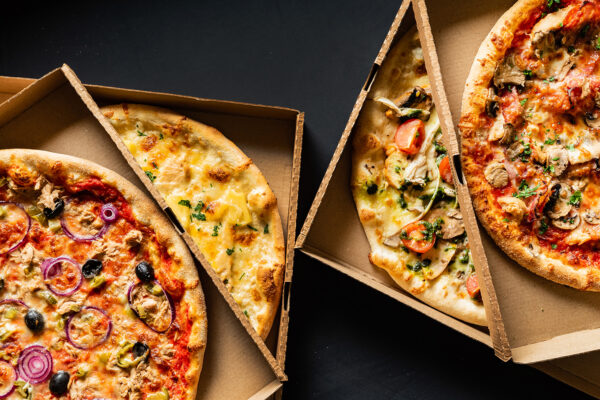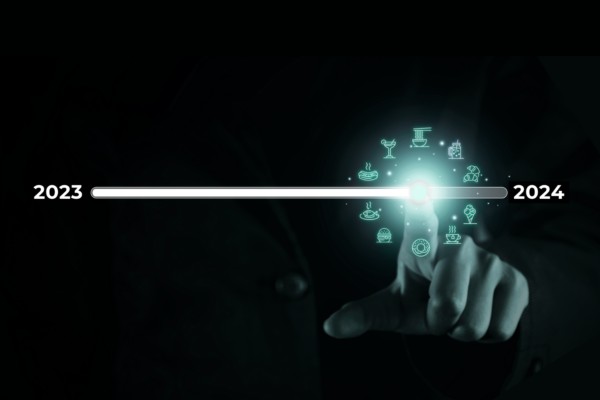It’s not only hard to believe that we’re finishing up another decade, but it’s also hard to wrap our minds around just how much has happened in the past 10 years. Thinking back to a decade ago, we had yet to meet Amazon’s Alexa or Apple’s Siri. In fact, we hadn’t even gotten our hands on an iPad yet. Uber had yet to carry its first passenger, let alone deliver a meal. Instagram hadn’t showcased its first shots of avocado toast or turmeric lattes. And of course,
imagining products like the Beyond and Impossible Burgers on the menu at Burger King or White Castle would have seemed, well, impossible.
If all of that can happen in the last decade, imagine what can happen in the next 10 years. That’s why it’s already time to start thinking about the trends that will shape the year and years ahead. As we always do at Datassential, we’re breaking down our trend predictions into the macro trends that have the potential to impact every facet of the foodservice industry.
In addition to the continued political ramifications of new or changing policies and tariffs, an election year always brings a range of issues to the forefront, with healthcare and the climate crisis already playing a major role. The oldest members of Gen Z will begin entering the workforce en masse, bringing with them new behaviors, ideas, habits, and expectations.
In this blog, we invite you to open your mind to the possibilities and changes we’ll see in 2020 and beyond. Consider how they’ll impact you, your brands and products, your customers, and our society.
Digital goes IRL
The rules that separate the online world from the real world are merging, creating a future where every interaction has a digital foundation. In the past, there were two sets of rules–one for how the online world works, and another for how the “real” world works. But in the years ahead, online rules will increasingly become the default rules for many parts of our everyday existence.
Today’s personalized menu boards and kiosks mimic the experience of browsing YouTube and Netflix, with AI technology working behind the scenes to seamlessly personalize the experience and impact the consumer’s choices. These AI-managed experiences will only become more prevalent: this year McDonald’s acquired Dynamic Yield, a company based in New York and Tel Aviv that specializes in decision technology. McDonald’s says it will use the technology to update drive-thru menus based on the time, weather, or traffic, and it can also instantly suggest other items based on what the customer is ordering. In the future, these types of digitally-driven experiences will move away from phones and computer screens and enmesh themselves in our lives in more subtle and continuous ways.
After a slow start, wearable technology could become the next big technology boom, with options like Amazon’s Echo Frames and the Echo Loop digital finger ring being rolled out, while Apple is reportedly working on its own augmented reality headset and digital glasses. In the future, we may not even notice that the map in our glasses is directing us to a new restaurant based on what we’ve purchased in the past, or that our digital ring vibrates when our order is ready. These interactions will simply be a part of our everyday lives.
Plant-based finds its identity
With so many brands fearful that they’ll be left behind and rushing to adopt trends at an ever-faster pace, plant-based meats went from science fiction to the Burger King menu in record time. After that initial rush, however, consumers and companies are starting to grapple with this new reality and, in the year ahead, will question what plant-based really means and how products should be positioned.
Brands like Beyond, Impossible, and Awesome have made the product itself their brand, but as more companies enter the space and introduce new categories (watch for more plant-based chicken and seafood products to start hitting the shelves), will consumers continue to understand each brand’s product as its own distinct creation or will they merge into a single, broader category?
At the same time, after the initial excitement over these products dies down, the plant-based industry will have to contend with concerns over whether these products are truly healthier than conventional meats. Companies and categories that are threatened by the growth of plant-based options will also push back more aggressively, with the dairy industry acting as a warning for every organization that you can’t ignore changing preferences
and trends.
Food and the climate crisis
As the public dialogue shifts from “climate change” to “climate crisis,” the food industry will increasingly become a central part of the story. While in the past the focus may have been on fossil fuels or packaging, food itself is increasingly taking center stage as consumers, scientists, politicians, and companies grapple with the increasingly visible impacts of the climate crisis.
Constant news stories covering wildfires on one side of the planet, floods on the other side, and extreme heat and droughts everywhere in between, are changing public perception. According to a Washington Post and Kaiser Family Foundation poll, 8 in 10 Americans believe “human activity is fueling climate change” and “roughly half believe action is urgently needed within the next decade,” and numbers like these keep increasing.
Many companies are already changing how they do business, with wine and coffee producers moving production to new areas while agricultural scientists develop new crops that can withstand changing conditions and temperatures. Options like vertical farming and cellular
agriculture will become mandatory evolutions if we want to continue to have access to the ingredients consumers know and love.
With 2020 being an election year, coverage of the issue will only increase, potentially shifting public sentiment from “it’s good to be sustainable” to “we have to fix this right now.”
Rethinking service
How do you even define good service these days? In the past, the epitome of great service was the “white glove” treatment associated with fine dining, marked by extra attention and personalized care. Yet for many modern consumers, this type of service sends shivers down their spine—it’s too much. They want less eye contact, less direct interaction, and a more streamlined, information-driven experience enabled by technology.
These consumers praise brands like Sephora, which has offered color-coded baskets at some of its European stores—choosing a red basket means you want assistance, while a black basket means you want to be left alone. Or Uber, which introduced its “Quiet Mode” option earlier this year, letting a driver know that the customer prefers minimal interaction. Other customers don’t want to leave their homes at all, happily ordering goods and services online—after all, they can find anything they want, with plenty of information and customer reviews at their fingertips, and it will increasingly be delivered in minutes (for some food delivery options), an hour (Shipt, which brands like Targets use, often offers delivery in as little as an hour), or a day (Amazon has introduced one-day shipping options for millions of items).
As these same consumers enter the workforce and become the people offering the goods and
services, brands will not only have to rethink how they train their workforce but also how to continue offering a memorable, helpful brand experience. Some brands have started offering customers the option to request help through an app only when needed, while others are offering more opportunities to interact with a brand but on a customer’s own terms, such as through text messages or virtual assistants. In other words, in the future, white glove service
may be defined by a White Glove app.
Redefining “restaurants”
Google “restaurant definition” and you’ll get this: “A place where people pay to sit and eat meals that are cooked and served on the premises.” But is that true anymore? Ghost kitchens continue to expand across the country, whether it’s a dedicated ghost kitchen commissary or an existing restaurant brand that creates a delivery-only concept operating out of the same kitchen.
If we expand the definition of a restaurant to include these options, we have the potential to create a near-infinite number of virtual “restaurants” on-demand: a single brick-and-mortar restaurant could, in fact, be multiple restaurant brands on a delivery platform. A restaurant brand that only exists on an app could open for a single two-hour lunch block and disappear just as quickly; LTOs could make way for LTRs (limited-time restaurants).
At Brew’s Hall in Torrance, CA, the food hall may look like it has multiple different vendors, but these are little more than branded pass-throughs—they all lead to the same kitchen where food is prepared by the same chefs who work for the same management company. Starbucks comprises seemingly every type of restaurant format one can imagine under its brand, from delivery-only stores without dining rooms to the massive experiential Starbucks Roastery concepts with multiple dining formats under one roof.
New York City’s Health Department recently struggled with the question of what defines a restaurant when deciding to treat Farmer’s Fridge salad vending machines as restaurants. In the years ahead, could a self-driving car where robots prepare and deliver the food also be considered a restaurant? Meanwhile, “dark supermarkets,” the delivery-only retail equivalent of a ghost kitchen, are expanding the definition of a grocery store.
In the years ahead, rethink your idea of what a “restaurant” can be—it could open up new
opportunities early in the game.
Understanding authenticity
According to Datassential MenuTrends, 7% of menus feature the word “authentic” on them. But, when we use the term “authentic” to refer to a food or dish, what do we actually mean? It’s an important—and fraught—question for the food industry at a time when consumers increasingly want to try new foods from around the world, yet questions of cultural appropriation and stereotypical ideas of “authenticity” remain.
Authenticity can also be harder to define as cultures and cuisines around the world evolve at an ever-faster pace, while chefs today may have a multi-hyphenate cultural background and extensive global life experiences that inform their cooking.
In the years ahead, the industry will need to develop a more nuanced understanding of “authenticity” and what it means for their concepts. In fact, there’s some evidence it’s already happening—while used on 7% of menus today, “authentic” is down from a peak of 9% about a decade ago, and our Haiku machine learning engine predicts it will fall another 6% in the next 4 years.
In with the new
In addition to the trends discussed, there are some even bigger factors that will be on everyone’s minds in 2020, each with the potential to impact the industry. The possibility of a recession looms large: the New York Times recently reported that “things look better now than they did last summer, but there is still cause for vigilance.”
Consider how this range of macro trends could impact your business, from developing an application to introducing a plant-based alternative, or even opening up a ghost restaurant. Stay on top of how these trends will evolve with FoodBytes, our monthly trend report.












